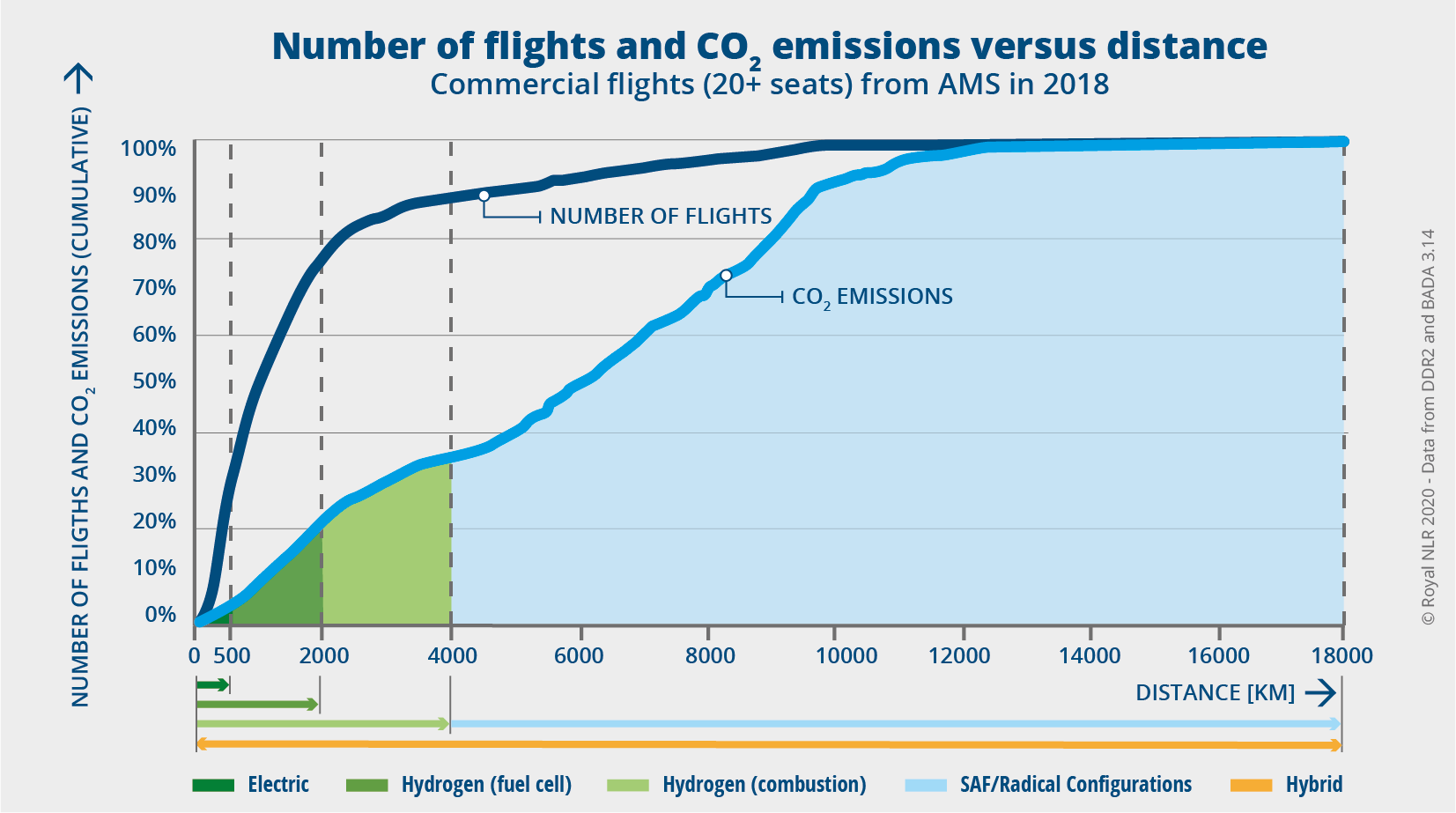Technological developments and radical innovations
Challenges
Over the past fifty years, fuel consumption per passenger kilometre flown has decreased significantly. This makes flying a very efficient way to travel. The noise produced by aircraft has also decreased dramatically. However, due to the large number of flights worldwide, there is a need for a further reduction in climate impact. The following challenges show that this is a difficult task:
- The energy requirements of an aircraft are enormous. Intercontinental aircraft in particular – like an A380 – require considerable power for take-off.
- Kerosene has a high energy density to deliver that desired power. Currently, there is no sustainable alternative available to provide the same amount of energy:
- Biokerosene or synthetic kerosene produce far lower CO2 emissions, but there is still not enough of this sustainable kerosene available. In addition, the entire chain – including production and transport – must contribute to reducing the burden on the environment.
- Batteries are relatively heavy, take up a lot of space and maintain their weight throughout the flight. NLR therefore does not anticipate the use of batteries in the future – even with the most ambitious forecasts – that could keep a large aircraft in the air for a long distance.
- Hydrogen as an energy source does not produce CO2 emissions, but storing it in the aircraft is a technical challenge: hydrogen in liquid form requires a very low temperature and, in the case of gas, the tank must be able to withstand extreme pressures.
No single solution
With the above challenges in mind, there is no holy grail that solves the climate impact caused by the current generation of aircraft. The graph below shows a sum of all departing commercial flights from Schiphol in 2018.
For different flight distances, the above future configurations are, with today’s knowledge, the most suitable sustainable alternatives.
If we take a closer look at the CO2 emissions, we see that 75% of all flights do not exceed 2,000 km. Together, these flights are responsible for 16% of all CO2 emissions. This means that the remaining long-haul flights (the minority: 25% fly further than 2,000 km) are responsible for the remaining 84% of these emissions.
The challenge, therefore, is to find an alternative for long-haul flights. Heavy batteries will, in any case, not offer a solution. Therefore, in order to tackle the whole spectrum in an efficient and effective manner, we must rely on different solutions, depending on the distance to be covered.
The following aspects play an important role in this regard:
- The energy source
- The construction and aircraft configuration
- The way aircraft are used
- People: flight behaviour and policy
Energy sources
To replace fossil fuels, batteries, hydrogen and sustainable kerosene offer solutions for the future. This includes the following configurations, or a combination thereof (hybrid form):
- For flights of up to 500 km, with up to 19 passengers on board, electrically powered propeller aircraft are the most suitable. For these relatively small aircraft, a battery may provide the necessary energy in the near future.
- Aircraft for distances up to approximately 2,000 km can be fitted with electrically driven propellers using hydrogen as an energy source. In this case, a fuel cell converts chemical energy into electrical energy.
- For longer flight distances of up to 4,000 km, jet engines still remain the most efficient; however, with hydrogen as the energy source that burns in the engines.
- For even longer distances – more than 4000 km – the use of Sustainable Aviation Fuel (SAF) offers the most advantages. The efficiency of other energy carriers is too low. The current generation of aircraft can use this without any modifications.
Radical innovations
In addition to alternative energy sources, there are other solutions that help make aviation more sustainable. These include:
- the use of more lightweight construction parts – for instance, made of composite materials – which require less fuel.
- making aircraft more aerodynamic so that the air resistance decreases. For instance, the use of laminar and ultra-slim wings.
- propulsion that is more efficient than that of the current generation of aircraft, through the use of engines with even larger turnover ratios, boundary layer intake and distributed propulsion.
- electric taxiing at the airport, reducing emissions at the airport.
- new aircraft configurations: with other propulsion techniques, an aircraft no longer needs to consist of a separate fuselage and wings.
Not just the aircraft
Tackling the energy source issue or introducing constructive innovations relate to the aircraft. However, there are also other, more indirect, measures. By finding the right balance, these too will have a positive effect on the climate impact:
- The Single European Sky project aims to create a joint European air space that is currently a ‘patchwork’, making flights unnecessarily long.
- Continuous Descent Approach ensures that less fuel is required during landing and the aircraft produces less noise.
- During the cruise phase, climate-sensitive areas can be avoided.
- Aircraft can fly slower and/or lower, thus reducing the impact on the climate.
- By introducing more stopovers for long-haul flights, less fuel needs to be carried. This makes an aircraft lighter and reduces CO2
- NLR is studying how the sustainability of a flight can be quantified using so-called environmental scores: ‘high-emission flights’ with a ‘low-emission’ aircraft or ‘very low-emission flights’ with an older aircraft. What is better and how can this be achieved?
- Circular aviation – including circular airports – considering the whole chain. During the design process by means of a Life Cycle Analysis, consideration is given to how parts can be reused after the end of their service life.


